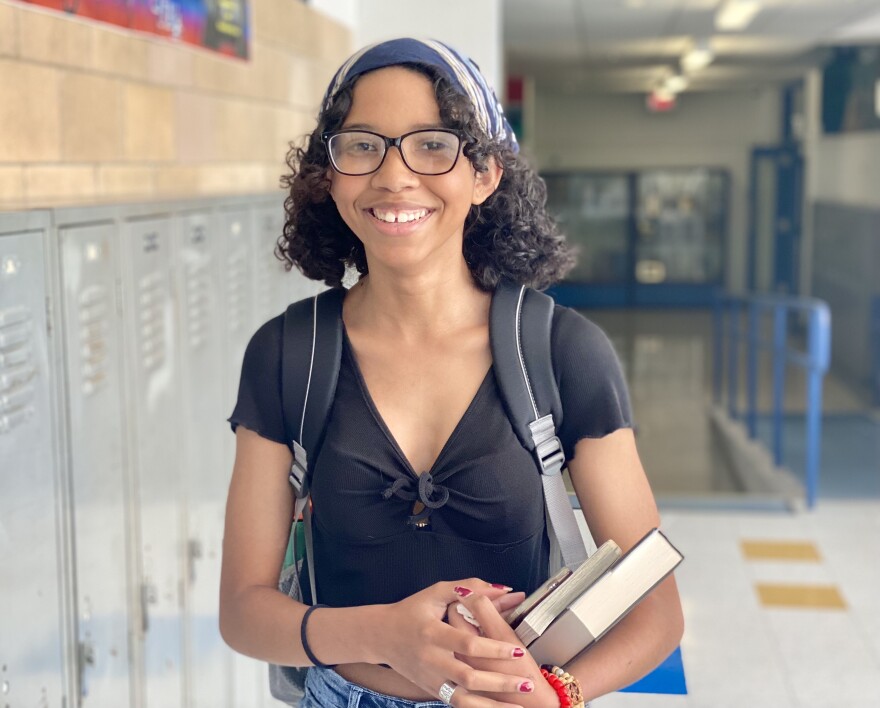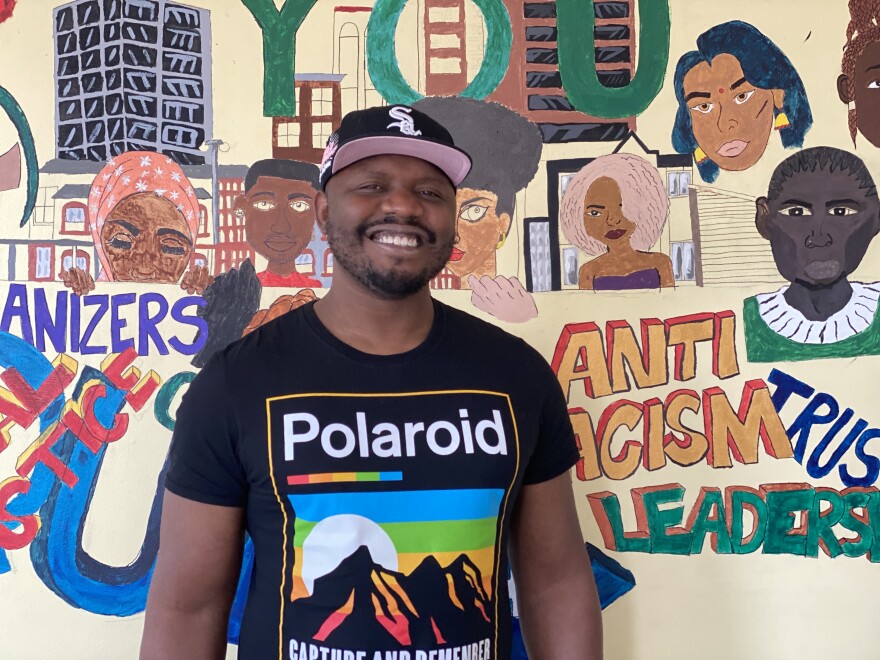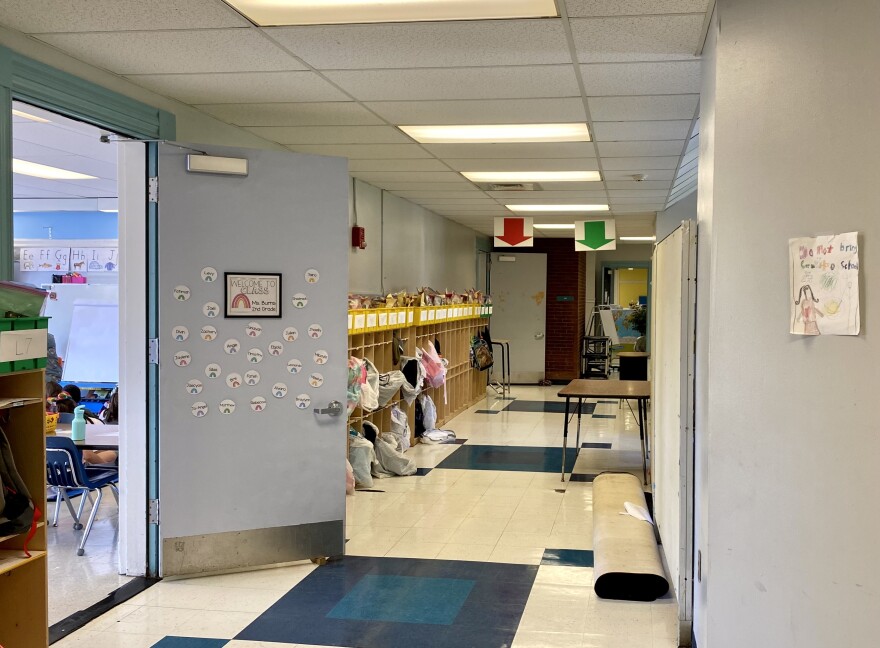How New England’s lack of teacher diversity is affecting students at N.H.’s largest school district

Mackenzie Verdiner, a rising junior at West High School, says that the few Black staff in the building are like a “beacon.” (Sarah Gibson/NHPR)
Mackenzie Verdiner goes to one of the most diverse schools in New Hampshire, Manchester’s West High School. Students there speak about 50 different languages.
“If I grab a fistful of kids randomly, it would be a different color on each finger — it’s all different colors, different backgrounds,” she says. “And then all the teachers are all the same.”
In other words, white.
In the last 20 years, the number of students of color in Manchester has more than doubled. Nearly half of students in the city’s public schools are now non-white — predominantly Latino or Black — but the same applies to less than 5% of Manchester’s school staff.
This mismatch between teachers and students is a reality in schools across the country, but it is particularly stark in New Hampshire.
According to federal data, 98% of teachers in the state are white. This is driven in part by the region’s demographics. But it also reflects the hurdles people of color face when trying to pursue a career in education in local schools.
No matter the causes, local students and educators say this lack of diversity among New Hampshire teachers has profound consequences — hindering students’ academic success, well-being and opportunities after graduation.
Mackenzie, who’s Black, says she’s only ever had white teachers. She does well in school, but she wonders what it would be like if the staff were more diverse.
“I feel like people don’t understand why it’s important to have someone who looks like you teaching you…to see what Black success can look like,” she says. “It’s so important on so many levels.”
Multiple studies show that for students of color, having at least one teacher of color is linked to improved attendance, test scores, graduation rates and college attainment. Research has also found that teachers of color often have higher expectations for their students of color.
And this could make a difference in cities like Manchester, where there are deep racial disparities in academic performance. According to an analysis by the nonprofit Manchester Proud, students of color are far less likely than their white peers or the rest of the state to reach proficiency in reading and math. Fewer of them take advanced classes and enroll in four-year colleges.
While some teachers in the district embrace the growing diversity of their students, the gap between students and staff has contributed to breakdowns in communication and trust.
About 18% of students in the district are learning English as a second language, many of them Latino. After advocates and parents raised concerns about linguistic barriers, the Manchester school district hired more bilingual staff. But many communication hurdles remain.
In an effort to address racial disparities, the Manchester schools also recently expanded diversity and equity training for staff. Some say these initiatives don’t do enough to shift school culture.
Favour Ben-Okafor, a senior at West High School, says white staff don’t always know how to correct racism or cultural misunderstandings in the classroom.
Favour, who is Black, recalled one uncomfortable interaction with a white classmate who kept repeatedly asking if her hair was real. Favour says she left that class blaming herself for not knowing what to do. Maybe, she thought, she could have said something to correct the student. That way, other Black students might not have to deal with the same behavior.
But Favour said things also might have been different if her white teacher had intervened.
“It made me think: If this was a Black teacher, would they say something?” she says. “Would I get that defense, would they tell the person that’s not an OK question to ask?”
The demographic divide between students and teachers exists in districts across the country, and according to one analysis, it’s growing.
In northern New England, this is particularly pronounced in cities, where most of the region’s young people of color reside.
Data from the 2020 census shows that about 45% of those under age 18 in Manchester and Nashua are people of color. The same is true for about 43% of the under-18 population in Portland, Maine, and about 38% of those in Burlington, Vermont.
There are a number of reasons for these trends. Northern New England is aging rapidly, and a larger proportion of its mostly white residents are past their child-bearing years. Meanwhile, the modest population increases in New Hampshire, Vermont and Maine have been driven almost entirely by people moving in from other states or countries.
And these new residents are having kids.
“The population that migrates tends to be in the family part of their life cycle,” explains Kenneth Johnson, a demographer at the University of New Hampshire. “In some cases, they bring children with them, but they also bring the potential for additional children in the coming years.”
The increase in students of color at New Hampshire public schools comes amid a long-term decline in overall enrollment.
In Manchester, both of these trends were accelerated by a major change in the district over a decade ago.
For years, the predominantly white town of Bedford sent local students to Manchester West High School. But in 2007, Bedford opened its own high school, and many families stopped sending their kids to Manchester. In the next three years, the Manchester school district lost over 2,500 white students, many of them at West High.
For most schools, recruitment is a challenge

Sudi Lett stands in front of a mural drawn by students he mentors in Manchester, N.H. (NHPR)
When Sudi Lett graduated from Manchester Central High School in 2003, he was one of just a few Black students in his class.
After college, he returned home. He thought about becoming a teacher, so he picked up substitute teaching shifts and worked as a paraprofessional, which paid about $10 an hour. It didn’t seem promising.
“Professionally, teachers aren’t as respected as they should be — I mean, not even close, socially and economically,” he said. “I didn’t think that that would be a viable career for me here.”
Lett suspects many students of color today come to the same conclusion. He now works as a youth and education coordinator at the progressive Granite State Organizing Project and coaches basketball at Central High School. And he says there’s not enough happening in Manchester to convince young people of color who might be interested in teaching to stay.
“If you’re not an outdoorsy kind of person and you’re not a huge go-to-a-bar-or-pub kind of person, it’s really slim pickings,” he says of the city.
Much of the diversity among the staff at Manchester’s public schools is largely because of partnerships with youth nonprofits in the area, such as City Year, Gear Up and My Turn.
At Manchester West, a My Turn staffer is one of the few Black adults in the building. Mackenzie Verdiner says that students turn to her for support daily.
“She’s like a beacon at the school,” she says. “Everyone wants to be in her room.”
Lett says students often come to him to make sense of racism in their schools. He says having personal experience with it allows him to talk with students about what racism is — and isn’t — in a way that white teachers often struggle to do.
“I’ve heard kids say ‘This teacher is racist. I’m like, ‘Oh are they? Do you go to class on time?’” Lett laughs. “The racist thing is the last thing. You want to make sure everything is in line first, and if everything is in line and there’s no other explanation, we can talk about that.”
Teachers of color shoulder ‘a big responsibility’

Tina Philibotte, a former Goffstown high school teacher, in her new role as the Chief Equity Officer for Manchester schools. (Sarah Gibson/NHPR)
Tina Philibotte, who is Asian American, grew up in Manchester and taught in the Goffstown School District for 13 years. For most of that time, she says she was the only teacher of the color in the entire district.
“I felt alone,” she says. “And the reason I felt alone is because in many ways I was.”
Students of color often sought her out for support.
“They’ll come to you and they’ll tell you what’s going on, what they’re experiencing in their classrooms, and you have to hold that with them,” she says. “That puts a big responsibility on educators of color.”
Now, Philibotte is serving as the first equity officer for the Manchester school district. Among her tasks is figuring out how to retain and recruit staff of color, at a time when schools are facing heightened scrutiny around their handling of diversity in the classroom.
A 2021 state law prohibits schools from teaching that one group of people is inherently racist, superior or inferior to people of another group. It was part of a wave of legislation passed across the country, modeled after an executive order issued by former President Trump.
The law does not explicitly ban teaching about racism, but a lawsuit backed by a group of local educators alleges that it’s had a chilling effect on teachers because they avoid the topic out of fear of being censured or losing their license.
Philibotte, one of the plaintiffs in that court challenge, says the law is making it harder for districts that are actively trying to recruit a more diverse workforce.
“A part of the law is saying: ‘We need folks to be colorblind.’ That is what people are hearing,” she says. “And so that is not the kind of space where a person of color wants to come and educate children.”
State officials dispute these allegations, pointing to guidance issued by the Department of Justice and Department of Education clarifying what can be taught and noting that lessons about racism that make some students “uncomfortable” may still be allowed.
Creating a student-to-teacher pipeline

Henry Wilson Elementary School, a K-5 school of about 440 in central Manchester. (Sarah Gibson/NHPR)
States across the country have been trying for years to recruit a more diverse educational workforce. And the issue is getting more attention, as the pandemic highlights staff and teachers shortages.
One program in Connecticut is recruiting and training teachers of color, with the dual goal of diversifying the workforce and addressing the workforce shortage. In Providence, Rhode Island, the public school system is offering college loan forgiveness for educators of color. And in Portland, Maine, voters recently approved funding for a teacher diversification initiative.
But progress can be slow. Thirty years ago, a federal judge ordered the Boston public school system to ensure that 25% of its teachers are Black, as part of the city’s desegregation efforts. But, as reported by the Boston Globe and other local outlets, recent efforts to diversify school staff haven’t made a significant difference.
In New Hampshire, a loose coalition of people working in education, business, nonprofits and government are teaming up with the U.S. Department of Labor to explore possible solutions.
And in Manchester, Tina Philibotte and other educators are working with Manchester Community College and other colleges to explore pathways for people of color to enter the school workforce.
One possible model would provide support for students to take advanced classes, enroll in a four-year college and do their student teaching in Manchester schools as they work towards their degree.
But even if that program gets off the ground soon, it could take years, even generations, to see substantial results.
“This is not something you’re gonna see come to life in a year or two years,” Philibotte said. “There’s a lot of capacity building that we have to do first. And the reality is: that has not happened yet, and we are really and truly creating this work right now.”
